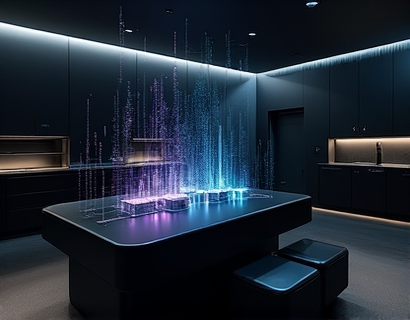Elevate Your Live Presentations: Harnessing AI Avatar Technology for Real-Time Engagement and Dynamic Communication
In the rapidly evolving landscape of digital communication, businesses and content creators are constantly seeking innovative ways to captivate and engage their audiences. One of the most promising advancements in this domain is the integration of AI avatar technology into live presentations and virtual events. This cutting-edge solution merges advanced artificial intelligence with creative design to create lifelike avatars that can deliver messages with unparalleled impact and creativity. By leveraging this technology, presenters can transform their digital interactions, setting a new standard for engagement and communication.
The concept of using avatars in digital communication is not new, but the integration of AI has revolutionized the way these virtual characters can interact and communicate. Traditional avatars were often limited to pre-recorded animations or basic text-based interactions. However, with the advent of AI, avatars can now process and respond to real-time inputs, making them highly dynamic and interactive. This real-time capability is crucial for live presentations and virtual events, where the ability to engage with the audience instantly can significantly enhance the overall experience.
AI avatar technology works by combining computer-generated imagery (CGI) with natural language processing (NLP) and machine learning algorithms. The avatar is designed to mimic human-like movements and expressions, thanks to advanced 3D modeling and animation techniques. The NLP component allows the avatar to understand and process spoken or written input, enabling it to respond appropriately to questions, comments, and other audience interactions. Machine learning algorithms continuously improve the avatar's performance, making it more natural and engaging over time.
One of the primary benefits of using AI avatars in live presentations is the ability to maintain audience attention and interest. Traditional presentations can sometimes suffer from a lack of engagement, especially in virtual settings where distractions are abundant. An AI avatar can break through this barrier by providing a unique and interactive presence. The avatar can use gestures, facial expressions, and even tone of voice to convey emotions and emphasize key points, making the presentation more relatable and memorable.
Moreover, AI avatars can be customized to fit the brand or the specific needs of the presentation. Designers can create avatars that reflect the company's identity, industry, or the personality of the presenter. This level of customization ensures that the avatar not only looks professional but also resonates with the target audience. For instance, a tech company might opt for a sleek, modern avatar with a futuristic design, while a healthcare provider might choose a more approachable and caring avatar.
Another significant advantage of AI avatars is their ability to handle multiple languages and cultural nuances. In global virtual events, where participants may speak different languages, an AI avatar can switch between languages seamlessly, ensuring that all audience members understand and engage with the content. Additionally, the avatar can be programmed to respect cultural norms and gestures, further enhancing the inclusivity and effectiveness of the presentation.
Real-time interaction is a cornerstone of AI avatar technology. During a live presentation, the avatar can respond to audience questions and comments immediately, creating a more dynamic and interactive environment. This immediate feedback loop not only keeps the audience engaged but also allows the presenter to address concerns and provide additional information on the spot. The avatar can also facilitate Q&A sessions, polls, and other interactive elements, making the presentation more participatory and engaging.
For content creators, AI avatars offer a powerful tool to enhance their online presence and reach a wider audience. In the realm of social media and streaming platforms, an AI avatar can serve as a virtual host or co-host, providing consistent and high-quality content without the need for constant human intervention. This can be particularly beneficial for creators who produce regular content but struggle to maintain a consistent human presence.
Furthermore, AI avatars can be used to create virtual assistants that guide users through complex processes or provide personalized recommendations. In educational settings, an AI avatar can act as a virtual tutor, offering explanations, answering questions, and providing feedback in real-time. This personalized approach can significantly improve learning outcomes and student engagement.
The technical underpinnings of AI avatar technology are complex but fascinating. At the core, the avatar is a 3D model rendered in real-time using powerful graphics processing units (GPUs). The avatar's movements and expressions are controlled by a combination of pre-defined animations and real-time motion capture data. The NLP component uses natural language understanding (NLU) to interpret user input and generate appropriate responses. Machine learning algorithms continuously train the avatar based on interactions, improving its ability to understand and respond to a wide range of scenarios.
To implement AI avatar technology in live presentations, organizations can follow several best practices. First, it's essential to define clear objectives for the avatar's role in the presentation. Whether it's to introduce topics, answer questions, or facilitate discussions, having a clear purpose will guide the design and functionality of the avatar. Second, invest in high-quality design and animation to ensure the avatar looks and behaves naturally. This includes detailed 3D modeling, realistic facial expressions, and smooth motion.
Technical setup is also crucial. Ensure that the presentation environment has robust internet connectivity to support real-time interactions. Use platforms or software that are optimized for low latency and high performance. Testing the avatar's performance in a simulated environment before the actual event can help identify and resolve any technical issues.
Another important aspect is training the avatar with relevant content and scenarios. This involves feeding the avatar with a comprehensive dataset of possible questions, statements, and responses. The more diverse and comprehensive the training data, the more versatile and effective the avatar will be. Continuous refinement and updates based on user feedback and interaction data will further enhance the avatar's performance.
While the benefits of AI avatar technology are numerous, it's important to address potential challenges and considerations. One common concern is the potential for the avatar to come across as unnatural or robotic. To mitigate this, focus on creating a balance between human-like behavior and the unique qualities that make the avatar stand out. Incorporating subtle human-like imperfections, such as slight delays in response or occasional humor, can make the avatar more relatable and engaging.
Privacy and data security are also critical considerations. Ensure that any data collected during interactions is handled securely and in compliance with relevant regulations. Transparency about data usage and providing options for users to opt-out can help build trust and confidence in the technology.
In conclusion, AI avatar technology represents a significant leap forward in digital communication and engagement. By integrating advanced AI with creative design, organizations can create lifelike avatars that deliver messages with impact and creativity. These avatars can transform live presentations and virtual events, making them more interactive, engaging, and memorable. As the technology continues to evolve, the possibilities for enhancing digital interactions will only expand, offering new opportunities for businesses and content creators to connect with their audiences in innovative ways.












